Parallette Training - Volume 2 - The Press to Handstand
The press to handstand is an incredible tool for developing strength in the shoulders and upper back. It is also an impressive feat in its own right. While a press to handstand is not terribly difficult to execute once learned, it can take a while to develop the required strength, flexibility, and understanding of the technique.
Once learned, it can be modified continually to progressive increase the demands of the skill.
Some flexibility is essential to execute a press handstand with correct technique. The ability to do a decent "pancake" (a forward bend with straight back from a seated straddle or pike on the floor, so that your chest contacts the floor or your legs) will help maximize efficiency of the movement.
Most of the following handstand drills can be performed either on the floor or on parallettes. In general, working the drills on parallettes will make the movements easier. The parallettes create a more stable base for the handstand as well as providing more clearance for presses from the L or straddle L. If you use parallettes, start with your feet on a mat or other raised surface so your feet are level with your hands to start. Once you begin to develop some proficiency with the move, you can lower or remove the mats.
Press to headstand
To learn a press to handstand, you must first learn a press to headstand. Start by placing both hands on the floor about shoulder width apart, then place the top of your head on the floor about 8 inches in front of your hands. From this position straighten your legs and pull your feet in toward your face so that your toes are on the floor and your hips are directly above your head. This is the key position that must be learned to progress to a press to handstand. From this position you should be able to straddle wide and slowly lift your hips and legs into a headstand with a bit of pressure on your hands. This movement should not require much effort. If you find you are pushing hard with your hands to get your feet off the ground then your hips are not directly above your head. Return to the previous position and try to ensure that your torso is completely vertical. Once you have lifted to a stable headstand, practice lowering your toes to the floor in a straddle position, lightly touching your toes on the floor, and then pressing smoothly back up into a headstand. Throughout this motion your hips should remain directly above your head.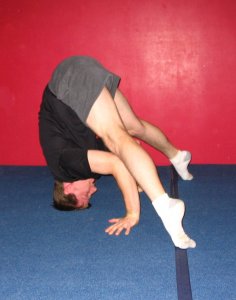
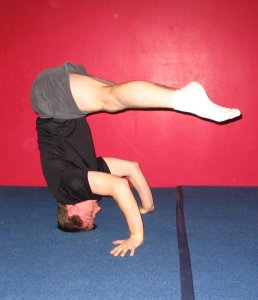

Handstand straddle down against a wall
Kick to handstand with your back against a wall. Straddle and lower your toes to the floor. This motion should be identical to the straddle down from headstand except that you are now on your hands with straight arms. Consciously keep your back pressed against the wall, maintain a hollow chest, and keep your shoulders extended and as open as possible.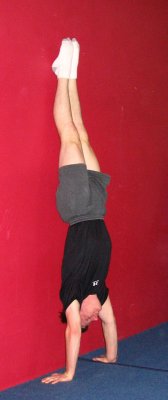
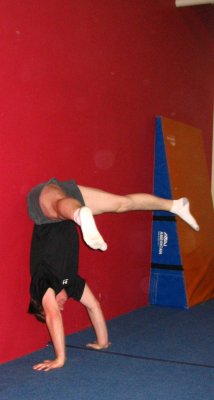
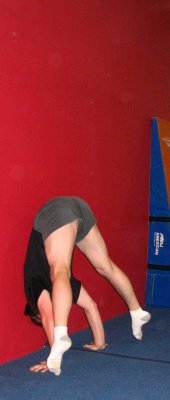
Press to handstand leaning on a wall
Stand facing a wall, place your hands on the floor a few inches away from the wall, and press up to handstand. Start with your shoulders directly over your hands and arms perpendicular to the floor, not angled back with shoulders closer to your feet. And, above all, remember to lift your hips completely before lifting your legs. Your lower back should contact the wall before your legs are brought up. Resist the temptation to bend your arms. A bent-arm press to handstand is markedly different than a straight-arm press to handstand, and working the press with bent arms will slow your progress to straight-arms. Reverse the motion, and straddle down controlled to the floor.
Press to handstand with a spot
There are a few basic methods for spotting a press to handstand. For the first method, stand facing the spotter, and then bend to place your hands on the floor so that your back is to the spotter and your shoulders are hips are aligned directly above your hands. The spotter places his hands on your hipbones. As you presses to handstand, the spotter should lift and pull your hips back toward himself. The spotter should not lift straight up, as this will hinder your ability to perform the skill. Instead, the spotter should just keep your hips aligned and stabilized over your shoulders.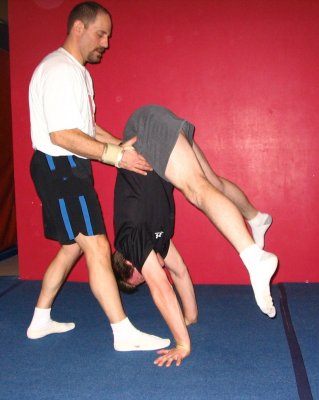
In both the first and second methods, the spotter's knees can be pushed against your shoulders to brace you and help open the shoulders in the press.
The second method involves the same start position as the first, but instead of grabbing your hips, the spotter will reach over your legs and grab your inner thighs. This allows the spotter to assist with the compression and straddle, helping to ensure proper body positioning.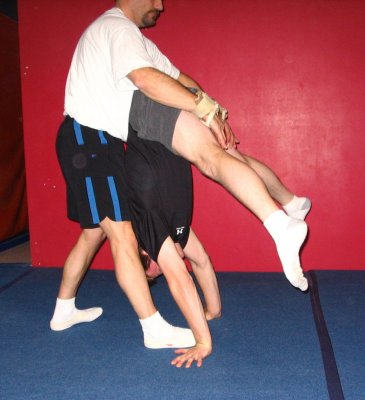
The third method's start position involves the spotter standing to one side of you. If the spotter is on the your left side, he will place his right hand on the your upper back and left hand on the your stomach. This enables the spotter to assist with opening the shoulders in the press.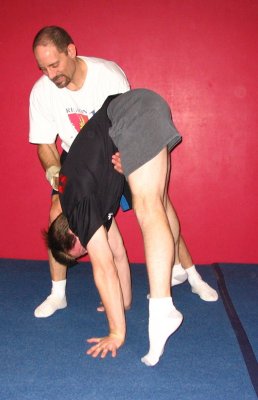
As with all spotting, it is the spotter's job to reinforce proper technique and minimize involvement in the action. He should do as little work as possible to get you in to the handstand.
Press to handstand from a straddled stand
If the preceding progressions have been trained, the next step is to work on a freestanding straddle press to handstand. Continue to focus on opening your shoulders and lifting your hips over your head before lifting your legs. Think about compressing into a pancake as your feet lift off the floor. Your legs should go out to the sides, not back behind you.
Press to handstand starting with your butt against a wall
Once you have a press to handstand, or are very close, working a press to handstand starting with your butt against a wall will force proper technique. Start in a straddle stand with your butt against the wall and your hands on the floor a few inches from the wall. Press to handstand attempting to reach the handstand without your feet touching the wall. This drill forces you to lift your hips and bring your legs around to the sides rather than back.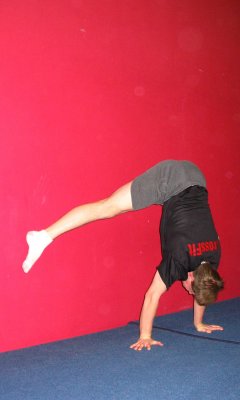
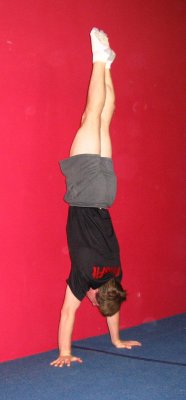
Press to handstand lower to straddle L
Once a press to handstand is accomplished, you should begin lowering to a straddle L out of every press handstand. This will further develop your press strength and reinforce proper positioning. It will also begin to develop the bottom part of the press which will allow you to press to handstand from an L or straddle L. From the handstand straddle, bring your toes down toward the floor. Keep your hips as high as possible throughout. Once your legs pass vertical, lift your toes in front of you and lower your hips into the straddle L. Aim to control this motion throughout.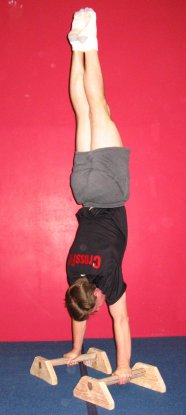
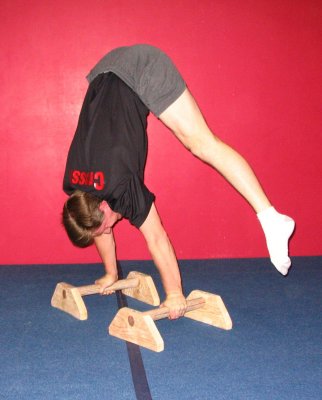

Straddle L press to handstand on parallettes
To press to handstand from a straddle L you must consciously think about pressing down on the parallettes, keeping your arms straight, and lifting your toes forward as you lift your hips backward. It is natural to want to kick your heels back as you start the press but this makes the press significantly more difficult. Lift your toes to compress into a pancake as far as possible to reduce the load on your shoulders. As with the other drills, once the handstand is obtained you should lower back down to straddle L. Once this skill is attained on parallettes it can be moved to floor.
L press to stand on parallettes
This drill helps to teach the required compression and proper technique for an L press to handstand. From an L-sit on parallettes, lift and press your hips back and over your head until you can place your feet on the parallettes behind your hands, with legs straight and in a partial straddle. The goal is to compress into a pike as much as possible and place your feet on the parallettes as close to your hands as possible.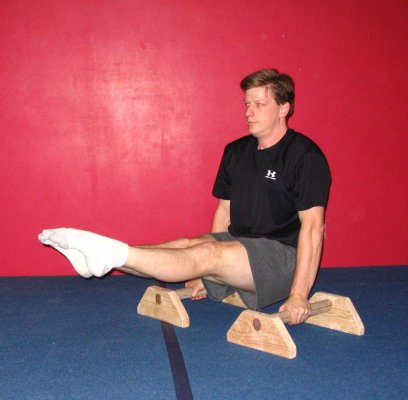

L press to handstand on parallettes
If you can press to stand on parallettes and you can perform a straddle press to handstand from straddle stand, then an L-press to handstand on parallettes is simply combining the two. Start in an L-sit on parallettes and then lift and compress into the pike as much as possible. Lift your hips and press through the straddle stand position and continue into the handstand. Be sure to lower back down to the L after the press is completed.To increase the difficulty and improve technique and compression, tape a broomstick or rod across the parallettes just behind your hands. This will force an intense compression in the press in order to clear the rod.
Standing pike press to handstand
Start in a standing pike. Lean forward and lift your hips to press to handstand while keeping your legs together. It is essential to lift your hips into the handstand before lifting your legs to maximize efficiency in this movement. Focus on keeping a tight pike as long as possible.

Straddle planche press to handstand
This is the first press in which all previous techniques are ignored. This press requires an initial lifting of the heels and lowering of the hips to reach a planch position. (An understanding of the planche is assumed (see Parallette Training, Part 1) Focus on intensely tightening your shoulders as you press into the planche. Then press to handstand by leaning slightly forward and pushing your hips into the handstand. Do not lift your heels and arch, rather press your hips to the handstand while maintaining an open-hip straddle position.
Wide-arm press to handstand
Start in a straddle stand as with other presses but instead of placing your hands directly beneath your shoulders, turn your fingertips outward and place your hands as wide apart as possible. Eventually, this can be done with your head within an inch of the ground. All previous press techniques apply. Be sure to first lift your hips up, then bring your legs around to the handstand.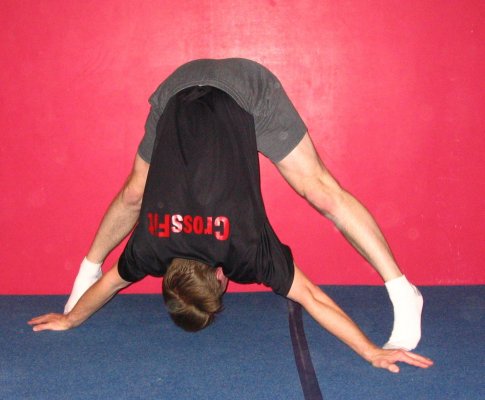
Assistance Exercises
Seated leg lifts will help train the compression required for an efficient press. Work them with your legs in a straddle and also in a pike. Sit on the floor in a straddle or a pike. Place your hands on the floor in front of you (straddle) or just outside your knees (pike), so your torso is leaning forward slightly. Keeping your butt on the floor, lift your feet as high as you can. The further forward you place your hands, the more difficult this will be.

Through the progressions describes here and with consistent, dedicated practice, virtually anyone can learn a press to handstand, though only a select few will ever accomplish some of the most difficult presses to handstand. Working these presses will give you a measure of your current strength, flexibility, and technique, as well as providing a tool to develop them further.
By Roger Harrell.
Related Events:
Parallel Bars
Floor
Related Skills:
Pike press handstand
Straddle kip to straddle L press handstand on one rail
Handstand
Handstand (2s.)
Handstand lower to straddle L
Stalder press to handstand
Straddle press handstand
Pike press to handstand from stand
V-press handstand
Wide arm press handstand from split
Piked press handstand with straight arms
